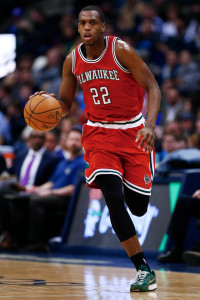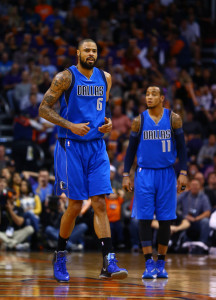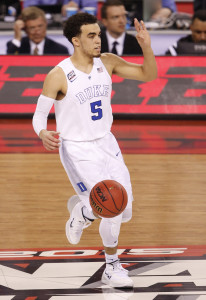In addition to our weekly chat, which Chuck Myron facilitates every Wednesday, we have a second opportunity for you to hit us up with your questions in this, our weekly mailbag feature. Have a question regarding player movement, the salary cap, or the NBA draft? Drop me a line at HoopsRumorsMailbag@Gmail.com or @EddieScarito on Twitter. Now for this week’s inquiries:
“If both Tim Duncan and Manu Ginobili return to the Spurs next season, what happens to San Antonio’s chances to land a big name free agent like LaMarcus Aldridge?” — Kelly
Well, the short answer is that it doesn’t help those chances one bit financially. But from a recruitment standpoint it would be a nice selling point for Spurs GM R.C. Buford to have in his pocket when he meets with Aldridge and his representatives. The appeal of playing alongside those two veterans, along with young star Kawhi Leonard, sure sounds better than what most teams would be able to sell Aldridge. And that’s on top of playing in his home state of Texas, which also happens to lack a state income tax, which would mean more of Aldridge’s salary would remain in his possession.
As for the numbers involved, the Spurs have roughly $34,159,326 in guaranteed salary on the books for next season already, not counting Leonard’s cap hold, which will be in the ballpark of $7,235,148. With the 2015/16 salary cap expected to be approximately $67MM, some quick math shows that would leave San Antonio around $25,605,526 to work with. If the team were to offer Aldridge a max contract, which is what it would likely take to reel him in, that would eat up roughly $19MM of that amount. While Duncan and Ginobili are both fantastic team-first guys, the idea of them splitting under $7MM of salary for next season seems like a tremendous flight of fancy to me. Of course, Aldridge could elect to take less, or sign a one-year deal to try and cash in on the expected salary cap jump in 2016. But those are extremely unlikely scenarios as well. So, if both veterans return next season, the Spurs probably can’t land Aldridge, or Marc Gasol, who is also reportedly on the team’s wish list this offseason.
“If the Mavs have to choose between signing DeAndre Jordan and Tyson Chandler this offseason, who should they pick?” — Deacon
This is going to be a difficult call for the Mavs this summer. Chandler is a great team guy who seems to love it in Dallas, and he obviously fits in with the franchise’s culture. Not a small consideration in the wake of how poor a fit Rajon Rondo was after being acquired from Boston. But Chandler, 32, is six years older than Jordan, which is a lifetime when looking at NBA big men. Chandler showed he can still be an asset with his play this season, but his best basketball is most assuredly behind him.
Jordan is currently in his prime, and will be coming off a very solid and highly productive campaign for the Clippers. Replacing Chandler with Jordan would certainly be considered an upgrade, both in the short-term, as well as over the life of a four-year contract, which is almost assuredly what Jordan will be seeking this offseason. The Mavs do need to work on getting younger, and adding a talented big man like Jordan would certainly help this process.
The wildcard here is what other moves the Mavs wish to make this offseason. I haven’t seen any reports on what kind of deal Chandler will be seeking this summer just yet. If he is interested in signing a short deal (one or two years), and would accept a paycut from the $14,846,887 he earned in 2014/15, then Chandler may in fact be the better option. If the team could retain Chandler for another season, then have him off its books in time for the summer of 2016, that may be the wiser move. But if both big men were seeking similar contract terms, then youth will always be the wiser choice.
“Now that Kevin Love is done for the year, what is your assessment of the Cavs/Wolves trade? Which team is the winner?” — Xavier
I don’t know that this trade can be fairly judged after just one season. Love being out of action for four to six months certainly doesn’t help Cleveland’s side of the ledger here. But if the Cavs won the title with Love in the lineup, then things would certainly be judged differently by many. Hanging banners from the rafters always paints risky roster decisions in a more favorable light.
As for the trade, I thought it was a bad move when the Cavs pulled the trigger on it, and I think the same thing today. Love’s injury aside, Cleveland gave up far too much for a player who has never proven that he is more than a stat sheet filler, and who can leave after this season to boot. Andrew Wiggins is a potential superstar, and I think Cavs fans will really begin to feel the sting of what could have been as he continues to improve and develop.
So if I have to crown a winner right now, then I’ll go with the Wolves on this one. They turned an asset (Love) who was almost assuredly going to be lost after this season to free agency, and netted themselves the Rookie of the Year. Wiggins has the potential to carry a franchise for years to come, and he also fits in well with what Flip Saunders is building in Minnesota. It’s hard to find fault on the Wolves’ side of things. However, if Love re-signs with the Cavs and they win a title or two during his tenure, then I’ll reassess my position.
“You’re on record as being a Knicks fan. What is your opinion of Phil Jackson forcing the triangle offense on the team for better or worse?” — Sammy
I take it that you’re not a fan of the system judging from your tone. That makes two of us. The league has changed quite a bit from when the Bulls and Lakers were winning titles and running that particular offense. Players who are entering the league nowadays are as a whole, less disciplined and experienced than in the past, and with the AAU pipeline emphasizing more of a ball-dominating style of offense, there are simply not enough players who can thrive in such a complex, and unselfish system like the triangle.
But I’ve also never been a fan of teams trying to shoehorn players into a particular system instead of designing one around the strengths of their rosters. Admittedly, the 2014/15 campaign isn’t a great case study in how effective the system can be in New York, considering the Knicks’ roster would have struggled to make the D-League playoffs this past season. But I’m not thrilled with the organization’s seemingly stubborn commitment to sticking with the triangle regardless of who is suiting up for the team next season. Time will tell on this one, but I can’t shake the feeling that Jackson will bolt by year three of his five-year deal, and then the team will have to start from scratch once again, rendering this whole triangle experiment pointless.
That’s all the space I have for this week. As always, I appreciate all of the submissions, and please keep them coming! I’ll be back next week with more responses and opinions.


